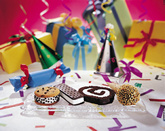Frozen novelties

Technical Editor, Food Product Design
Contents
Cool convenience
The cold, hard facts
Fruit in the deep freeze
Sweet sensation
Novelty reinforcement
Taking the plunge
Compounding the matter
Inclusion infusion
Color palette
Tasty freeze

Years ago, the frozen novelty category consisted of a few select treats, such
as single-flavor ice pops, ice cream sandwiches consisting of vanilla
ice cream surrounded by chocolate wafers, and vanilla ice cream on a
stick covered with a chocolate-flavored coating. However, today this
category encompasses everything from fruit-juice bars to multi-flavored
ice pops to ice cream sandwiches made with Oreo cookie bits in
vanilla ice cream, surrounded by Oreo cookie wafers.
An extensive variety of frozen novelties exist in today's market, due in part to advancing technology allowing for textural diversity. In addition, product developers have the ability to minimize the damage caused by temperature cycling during storage, otherwise known as heat-shock resistance, which improves quality throughout shelf life. Nowadays, bright colors, crunchy coatings, multi-textured and multi-flavored frozen novelties entice consumers of all ages, no matter what the season.
Cool convenience
Many novelties contain ice cream, while others contain a lower percentage of dairy ingredients
and are more sherbet-like in consistency. Some fruit bars have sorbet-like
characteristics, while ice pops or water ices are generally firmer in
texture. Ice pops are typically composed of water, a combination of
nutritive sweeteners, flavoring, acid, stabilizers and coloring.
The amount and type of dairy ingredient for ice cream is dictated by Title 21 of the Code
of Federal Regulations (CFR) 135.110, and for sherbet, 21 CFR 135.140.
Water ices, as governed by 21 CFR 135.160 are prepared similarly to
that of sherbet, except the water ice mixture does not require pasteurization,
and contains neither milk nor any milk-derived ingredient.
Although ice cream is produced for bulk packaging, as well as for novelties, there are
some differences worth noting. The overrun — the amount of air incorporated
into the ice cream mix — is generally less for novelties than for packaged
ice cream, which can be as high as 100%, notes James Nace, senior food
technologist, Universal Flavors, Fenton, MO. Novelties are more vulnerable to heat shock during distribution
than bulk ice cream due to their size and the amount of exposed surface
area. As a result, a coating protects most novelties, be it chocolate,
water or a layer of fat. Also, inclusions such as cookie, candy or nut
pieces generally need to be smaller than those used for bulk ice cream,
adds Nace.
Frozen novelties are either molded or extruded. Spade and bullet-shaped reusable molds
made from a metal alloy with good heat-transfer properties are commonly
used. Product is filled into the mold, which is immersed in a cold brine
(-40°F). A stick is inserted into the product while the mix is still
pliable. When the bar is ready for extraction, it moves to a "defrost zone" where the mold is sprayed with a warm brine (60° to 100°F)
that helps release the bar from the mold. Some processes incorporate
a back-suction step after filling, which leaves room in the center of
the bar for a different type of filling. Another type of mold, and one
that doesn't require extraction, is the sugar cone or the plastic cup.
Examples of extruded products include bars with sticks, ice cream sandwiches, and round-headed
ice cream cones. Ice cream also can be horizontally extruded into stickless
bars with a groove on the top surface to accommodate inclusions, such
as caramel and nuts. This is how many of the ice cream versions of popular
candy bars are made.
The draw temperature of the ice cream for molding is approximately 25° to 26°F, where "only
25% to 35% of the water in the formula will be frozen, giving a loose,
slushy texture, which readily takes on the shape of any mold into which
it is poured," explains Talbot. "By contrast, the ice cream
for extruded products needs to be sufficiently stiff to retain its shape
after extrusion through an orifice. For this reason, extruded ice cream
is made at draw temperatures of 19° to 21°F and contains 55% to 60%
frozen water."
Extruded ice cream novelties have better overrun control than molded novelties because
of the temperature differential noted above. "Super-premium category
novelties are almost always extruded and the overrun usually does not
exceed 70% to 75%," says Nace. "Premium extruded novelties
Both water-based and dairy-based novelties have textures that range from hard and icy,
to smooth and creamy. "With the freezing technology we have available
today and that we will have in the near future, texture in every product
category can be controlled," says Nace. "Standard water ices
In the past, water ices and fruit- and dairy-based bars often exhibited undesirable textures
ranging from iciness to gumminess. Iciness comes from the current freezing
process, which uses an ammonia-cooled media, which forms the cold brine
as described previously. "This slower freezing allows the larger
ice crystals to form, thus giving the bars an icier texture," notes
Nace. Newer, cutting-edge technology uses either cryogenic liquid nitrogen
(-320°F), or other quick-freezing agents, such as liquid carbon dioxide,
to promote more rapid freezing. "This quick freezing prevents large
ice crystals, thus giving a perceived smoother texture," adds Nace.
At times, individual products have contrasting textures. The core of a bar may be filled
with a fat-based filling that has a chewy-like consistency. Ice cream
could surround the core and be coated with a fat layer followed by cake
crumbs, nuts or candy sprinkles. Another type of multi-textured novelty
is a fruit bar containing an inner chewy fruit core made of fruit pieces
blended with sweeteners and carbohydrate-based gums, and covered with
a fruit-juice-based icy shell, notes Nace.
Purees or particulated purees — those with identifiable fruit pieces — are commonly used in
fruit bars. "As most fruits consist of 80% to 90% water, the product
developer must keep in mind the amount of water they are adding to a
finished product and how it alters the Brix and freezing point, which
impacts not only sweetness, but texture as well," says Nace. The
Brix level can be raised by using concentrated fruit juices, but since
Brix is a measurement of the concentration of sugar in solution, it
is affected not only by the fruit source, but by the addition of nutritive
sweeteners as well.
The sugar to acid ratio is critical to achieving optimal flavor balance. Adjusting this
ratio also impacts flavor intensity. "Acid levels are critical
to flavor release in most fruit-based desserts," says Nace. "In
water-based systems, citric acid and ascorbic acid can be used freely
without worry of product stability. In dairy-based systems, the system
may need to be buffered or stabilized to prevent protein denaturation,
depending on the milk-protein level and pH. The isoelectric point of>
milk protein is 4.6, which is the point at which the protein begins
to uncoil. Sugar and corn syrup solids help buffer the protein, but
phosphates can also be used as buffering agents. A controlled, slightly
denatured milk protein can produce a unique texture that is actually
a little creamier."
Sweet sensation
"Originally, corn syrup solids were added to decrease cost, but nowadays the consumers
like the texture produced with this ingredient, even though it gives
a different mouthfeel than 100% sucrose. It's a little warmer and softer," says Michelle Schwenk, food scientist, A.E.
Staley Manufacturing Co. (part of the Tate and Lyle Group), Decatur,
IL.
Corn syrup and HFCS also inhibit lactose crystallization, a defect that causes sandiness.
Lowering the lactose concentration in the formula also minimizes the
potential occurrence of this defect. Lactose should be kept at a level
where it remains insoluble, which involves keeping total milk solids
below 14%, notes Schwenk.
Since sweeteners depress the freezing point, the level used in formulation impacts the
freezing process, which in turn affects filling and packaging efficiency.
Fructose, dextrose and HFCS have the same effect on freezing-point depression
because it is a colligative property, and is therefore related to molecular
weight, as opposed to the type of molecule. "The corn syrup solids
are a lot larger than the fructose or dextrose, so they're going to have less of an effect," explains Schwenk. The lower the freezing
point, the greater the amount of available free water, and the softer
the texture. By the same token, the more free water that is available,
the greater the susceptibility to heat shock, resulting in the formation
of large ice crystals as the product goes through freeze/thaw cycling.
Higher sweetener levels increase the overall level of solids in the mix, which also impacts
the novelty's ability to freeze. In addition, with ice cream, the higher
the solids level, the higher the overrun needed to produce a desirable
texture. On the other hand, too low of a solids level adversely affects
the mix's body and foam structure.
Polydextrose is typically used in reduced-sugar applications, because it yields only
one calorie per gram vs. four calories per gram for sucrose. It enhances
mouthfeel as well. Maltodextrin adds viscosity to the mix, has some
water-binding capacity, softens the texture and decreases ice crystal
formation over time, says Schwenk.
A range of stabilizers exists, each with its own functionality. Some work synergistically with
other stabilizers depending on the desired function. In ice pops and
fruit bars, "stabilizers inhibit ice-crystal growth, provide creamy
texture, and prevent migration of flavor and color during freezing and
eating," notes Ulen. A blend of guar and locust bean gum (LBG)
is commonly used to provide heat-shock stability, and minimize iciness,
thereby providing a creamy texture. Another commonly used hydrocolloid,
carrageenan, helps prevent color migration in ice pops and "wheying
off" in ice cream mixes. Pectin is used in fruit bars, since it
stabilizes well in the presence of acid.
"In ice cream novelties, the primary function of stabilizers is the restriction of
ice-crystal growth in the finished product," says Ulen. "The
reduction of free available water is accomplished in two ways — by binding
water as water of hydration and by physically immobilizing the free
water. The addition of stabilizers assists in enabling the mix to achieve
its required viscosity. When products are subjected to heat shock, stabilizers
function to inhibit larger crystals from forming by restricting water
mobility."
Product lines that diversify by adding a no-sugar added or fat-free type, often require
different stabilizer systems that impart unique qualities. For instance,
the original version of a frozen novelty may be made with dairy solids
and dairy fat, nutritive sweeteners, cocoa and flavoring. This product
may contain gelatin, guar gum, methyl cellulose (MC) and LBG for stability.
"The gelatin has a high degree of water-binding capacity, which>
protects against heat shock, sets up as a three-dimensional network
structure that retards crystal formation, contributes to slow meltdown,
helps the novelty maintain its shape and improves mouthfeel," explains
Ulen. Guar and LBG also provide heat-shock resistance. In addition,
guar enhances body and smoothness, while LBG gives a warm eating-quality
sensation. MC contributes to the bar's meltdown properties.
In the no-sugar added variety, modified food starch, microcrystalline cellulose (MCC),
pectin and cellulose gum are added in addition to guar, MC and LBG.
Modified food starch provides body and thickening, and may give the
bar a pudding-like texture, notes Ulen. MCC imparts heat-shock resistance,
controls ice crystal formation and gives a chewy texture. Cellulose
gum — which provides smoothness and also gives a chewy texture —acts
much as MC with respect to meltdown properties. Finally, pectin can>
impart creaminess to the bar.
The fat-free bar contains modified food starch, MCC, cellulose and guar gum, plus mono-
and diglycerides, polysorbate 65 and 80, carrageenan and calcium sulfate.
Carrageenan prevents "whey off" in the mix and contributes
"The primary function of emulsifiers in frozen desserts is to improve whippability,
structure and meltdown properties," says Ulen. For instance, in
coated ice cream bars without a stable air-cell structure, the foam
matrix in the ice cream could collapse, causing shrinkage and a cracked
coating.
Taking the plunge
Achieving the desirable coating thickness and optimal drip and dry time is possible with various
trouble-shooting techniques, such as reformulating the coating, adjusting
the brine temperature in the molding tank, adjusting the percent overrun
of the ice cream and adjusting the coating temperature. For example,
if the product doesn't dry fast enough, higher melt-point oils can be
used, the fat content of the coating can be increased or the temperature
of the coating can be raised. Because the molded bar has a limited amount
of cooling capacity inside, the drying rate will decrease as the coating
is thinned out, explains Talbot. Since extruded bars are much colder
at the time the coating is applied, they can hold more coating, and
have greater cooling capacity.
Nut, candy or cookie pieces are applied to the outside of a novelty by using a technique
called dry-dipping. Bars or cones are typically dipped in a liquid,
fat-based coating prior to being dipped in the dry medium. This pre-dip
helps the dry matter stick to the substrate.
Ice pops may be dipped in cold water prior to packaging. This forms an ice-water shell
that protects the bar during storage and keeps the wrapper from sticking
to the surface of the pop.
The insides of ice cream cones are sprayed with a fat-based coating. This coating acts
as a protective moisture barrier so the cone can remain crisp throughout
its shelf life. Talbot cautions against contamination with water in
the spray system, which can cause grittiness. Use of lecithin helps
minimize the effects of potential water contamination. Additionally,
use of a 40-mesh screen removes oversized bits of grit that can contaminate
the process and stop-up the line. "Spray-coating temperatures are
typically in the order of about 104°F to 122°F," notes Talbot.
Fat-based coatings
act as a barrier by retarding moisture migration. Fats are combined
to minimize brittleness and cracking. "If you get too many cracks,
the efficiency of the barrier is greatly reduced," says Talbot.
Coatings used for novelties are generally referred to as pail coatings. With a fat content
ranging from 55% to 70%, pail coatings have nearly twice the fat content
of traditional compound coatings. The ingredients for both traditional
compound and pail coatings are the same, but the ratios differ. Sugar
predominates in traditional compound, while fat is the major ingredient
in pail coatings. Other standard ingredients include cocoa powder and
lecithin.
Pail coatings fats are liquid at room temperature and solid under refrigeration and freezing.
Those in confectionery coatings are solid at room temperature, notes
John Urbanski, vice president, technical sales and services, Wilbur Chocolate Company, Lititz, PA.
The fat blend affects
not only processing parameters, such as drying times and hardening parameters,
but brittleness and melt performance, as well. "There is a vast
difference in the solid-fat indices (SFI) of chocolate confections and
novelties. Novelties melt readily in the mouth, even when the mouth's
temperature drops while a cold novelty is being consumed. The ease of
melt will have an impact on flavor release as well as mouthfeel," adds Urbanski.
"Coconut is by far the dominant fat used for this application," says Wainwright.
"Partially hydrogenated and fractionated soybean and soybean/cottonseed
specialty fats have also been successfully used. These are designed
to rather closely mirror the melting profile of coconut oil, but they tend to be more pliable and exhibit delayed drip and dry times."
Blending 10% to 20% of a stable, nonlauric oil, such as soybean, peanut
or sunflower with coconut oil, is another alternative. This combination
creates a eutectic, which not only improves flavor release, but reduces
the tendency of the coating to crack; however, drip and dry times do
tend to increase.
"Nearly all novelty coatings are classified as compounds because they all have some
softer fat (e.g., coconut) added as a diluent fat. If made with real
chocolate, coatings generally are harder, more brittle, waxy and have
inferior flavor release," says Urbanski. "Apart from being
able to label it as real chocolate, there is little advantage in going
this route." Coconut oil is generally chosen as the diluent fat
with standard-of-identity chocolate. "The eutectic created between
the cocoa butter and coconut oil improves pliability and eating quality,"
adds Wainwright.
When chocolate is produced for confections, it is tempered to direct the polymorphic fat
crystals in cocoa butter to their most stable phase. This prevents low-melt-point
fat crystals from migrating to the surface, causing fat bloom. Tempering
also gives chocolate confections their characteristic shiny, glossy
appearance. Since novelty coatings are applied at low temperatures,
fat-crystal migration is not an issue, which renders tempering unnecessary.
Thus, without tempering, a lower-melting crystal polymorph is formed
and maintained under frozen storage temperatures.
Inclusion infusion
Baked inclusions and nuts absorb moisture from ice cream and the surrounding environment.
Use of a fat-based coating helps retard moisture migration. Nuts can
be oil-roasted or coated with a chocolate or other fat-based coating
to retard moisture pick-up. Praline coating may be applied via a panning
process to oil-roasted nuts. This sugar-based coating will dissolve,
to some degree, in ice cream over time.
At times, inclusions, such as cake or brownie pieces, are formulated with a low initial moisture,
which gives them a hard texture. Since the low-moisture pieces pick
up moisture from the ice cream during storage, they will actually have
a desirable eating quality by the time the product reaches the consumer.
The harder pieces will also be easier to process, because they are less
susceptible to breakage. Incorporating low-moisture marshmallow bits
produces a similar effect, since they soften over time, thereby increasing
their palatability.
There are alternate ways of delivering a cookie-type inclusion. "We do make some cookie-type
items that are derivatives of cookies, but they are fat-based," explains Talbot. "It's a way of introducing a cookie into an ice
cream in liquid form. We actually have a small amount of cookie in there,
and the whole flavor impact tastes like a cookie, but it's in a liquid
form that is pumped in like a variegate. It's not hard like a coating,
but firm, so it gives the impression of being a cookie. It's also another
way of making a variegate that doesn't need to be kept refrigerated,
and doesn't have any mold or spoilage problems, because it is fat-based."
Storage temperature affects the performance of inclusions. The temperature should be as
low as possible without causing condensation, notes Talbot. Too much
surface condensation causes clumping, which in turn causes problems
with metering product during processing. Conversely, if storage temperature
is too high, fat-based inclusions may stick together, or even melt.
Liquid inclusions need to be pumpable.
"Migration of solubles from the inclusion into the ice cream can result in a slight
increase in the solids concentration immediately around the inclusion," says Talbot. "In low-fat or nonfat ice cream, there is a risk of
lactose crystallization around the inclusion as a result of lactose
being thrown off balance by the increase in solids concentration. However,
with standard-fat ice cream, this is not a problem."
Colors could bleed from inclusions into the ice cream matrix. Sometimes this is a desirable
trait, because it gives a "halo effect" around the inclusion.
If color migration is considered a defect, use of colors that will not
dissolve or migrate, or use of a barrier around the inclusion, should
prevent this from happening, notes Talbot.
"Frozen novelties may be defined as easy-to-consume, individual servings of ice cream,
or other frozen confections, with an ‘added value' in the form of shape,
size, color, texture, flavor, or a combination of two or more of these," says Michael Talbot, ice cream technical sales, Shade Division of Kerry Ingredients, New Century, KS, and instructor of an ice cream novelties
course at Pennsylvania State University, University Park. Sometimes,
adding value means offering a no-sugar added or fat-free version of
an original product.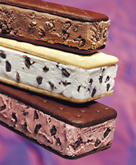
The cold, hard facts
Finished-product characteristics differ depending on whether the novelty is extruded
or molded. For instance, the draw temperature — which dictates the percentage
of frozen water present at the time the ice cream leaves the freezer
— also indicates the relative stiffness of the mix. Draw temperature
directly impacts ice-crystal size. The lower the draw temperature, the
smaller the ice crystals, and the smoother the finished product, notes
Talbot.
tend to be a little higher in overrun at 80% to 90%. Traffic category
extruded novelties, such as party slices, tend to push the limit, but
most do not exceed 95%."
tend to be very hard and icy. If you slush freeze a water ice, the texture
is softer. If you add specialized stabilizers and flash-freeze, the
texture can be much smoother. The same holds true for other categories
of frozen desserts."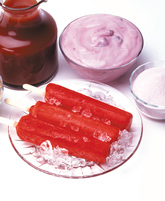
Fruit in the deep freeze
Fruit bars contain a variety of fruit-based ingredients, from juice concentrates
to purees to actual fruit pieces, with or without seeds, that lend authenticity
to the product. Some fruit bars are purely water-based, while others
have low levels of dairy solids and fat, to add richness and flavor.
"Traffic-quality juice bars must contain no less than 10% juice,"
says Nace. "Top-quality bars may contain 75% to 90%, but the largest
volume of bars are sold in the 25% to 50% range."
Sweeteners used in frozen-novelty formulations generally include sucrose, corn syrup
and HFCS, but may also contain dextrose, maltodextrin, fructose and
polydextrose. Sucrose tends to produce ice crystals, and is often used
in combination with corn syrup, which inhibits sucrose crystallization.
Corn syrup and HFCS not only provide sweetness, but build texture and
body, improve chewiness and help control meltdown in ice cream and other
frozen novelties.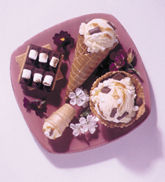
Novelty reinforcement
Stabilizers have multiple functions, many of which contribute greatly to texture. Novelties
require stronger stabilization than bulk-packed ice cream, because they
are subject to harsher processing and handling conditions. For instance,
extruded bars are formulated to be stiffer and dryer than bulk ice creams
because they need to hold their shape, explains Barbara Ulen, applications
manager for frozen desserts, SKW Biosystems,
Atlanta. Since novelties are small in size, temperature fluctuations
have a greater effect. Plus, bars coated with warm chocolate need to
have greater resistance to meltdown.
to mix viscosity. Calcium sulfate's primary use is to stiffen the product,
thereby improving extrudability, explains Ulen. The three emulsifiers,
mono- and diglycerides, and polysorbate 65 and 80, support air-cell
structure and foam stability.
Coatings are applied to frozen novelties via dipping, enrobing or spraying. Stick bars, for
instance, are commonly dipped in coating prior to packaging, while stickless
bars are enrobed. "After dipping, the bars drip for a short time,
typically 10 to 30 seconds," notes Talbot. "The bars should
be at least touch-dry before they are dropped into the wrappers. Time
from dip to wrap may be as short as 25 seconds or a long as several
minutes. Dipping temperatures for frozen novelties may be anywhere in
the range of 85°F to 104°F."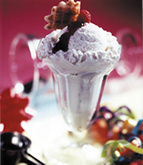
Compounding the matter
Frozen-novelty coatings have unique characteristics. The coating should melt rapidly
when consumed, and should be brittle and have a snap — yet not to the
point where it shatters during consumption. "Traditional chocolate
and confectioners' coatings are too viscous and the fat is too hard
for frozen novelties," says Bob Wainwright, manager, technical
sales, CT Refinery, Charlotte, NC. "Coatings must crystallize rapidly and leave a very thin, yet
non-transparent layer when applied over the frozen substrate."
Inclusions add both flavor and texture to a frozen novelty. Nuts add a crunchy contrast
to the snap of a coating and the smoothness of ice cream. Fruit pieces
contribute sweetness and chewiness to a bar. However, before adding
inclusions to the design of a novelty, the developer must be aware of
the effects of moisture migration and the proper methods of incorporating
inclusions.

